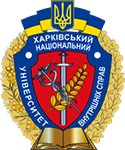Correlation of the terms “social order” and “public order”, “social security” and “public safety”
Abstract
It has been stated that the science of administrative law is faced with the issue of not replacing and/or unifying the terms “social order”, “public order”, “social security”, “public safety”, but rather with their coordination with each other, and as a result, it is proposed to focus on the difference between the adjectives “public” and “social”, which lies in the conditional scope of the concept “social”.
Public order applies to an indefinite number of persons and literally knows no boundaries, while social order is limited to a certain number of persons on the basis of certain characteristics or “interests”. It should be borne in mind that the terms “public order” and “public safety” are very broad concepts that include not only administrative offences and public order protection, but also a state (order) in which society is capable of progress and positive development with a minimum of fear that rights will be violated by third parties or due to the occurrence of special conditions.
Instead, social order and social security relate primarily to citizens or their individual groups in the state, it is essentially the establishment of the law and order in the country that is necessary to ensure such living conditions for citizens in which they feel inner harmony, have a stable psycho-emotional state and feel safe.
In conclusion, it has been noted that the proposed approach to understanding the analysed terms does not introduce an imbalance in the current legislation, and if this approach is used, it becomes possible to further harmonise the norms and approaches of international and national legislation. Moreover, if used, it levels the debate on the tasks of the police, since, while ensuring public order and security, it carries out much broader activities to detect, prevent and suppress administrative offences, which is one of the areas of police work under Article 23 of the Law of Ukraine “On the National Police”. Therefore, the terms under study can coexist, provided that the correct approach to their understanding is chosen, without any radicalism, but it is still advisable to clarify the provisions of the Law of Ukraine “On National Security”.
Downloads
References
Chyshko, K. O. (2020, April 9–10). Publicity as a terminological component of the categories of the science of administrative law: substantive characteristics [Conference presentation abstract]. Inetnational Scientific and Practical Conference “Public administration in conditions of changes and transformations: problems of organization and legal support”, Kharkiv, Ukraine.
Herasymchuk, R. V. (2022). The concept of public order as an object of administrative and legal regulation. Bulletin of Kharkiv National University of Internal Affairs, 3(98), 115–120. https://doi.org/10.32631/v.2022.3.10.
Komissarov, S. A. (2019). Concept and content of public order as a social phenomenon. Scientific Journal of Public and Private Law, 2(2), 72–77. https://doi.org/10.32844/2618-1258.2019.2-2.13.
Komissarov, S. A. (2019). The structure and main elements of the definition of “public order”. Entrepreneurship, Economy and Law, 9, 116–120. https://doi.org/10.32849/2663-5313/2019.9.19.
Panova, O. O. (2018). Ensuring public security in Ukraine: administrative and legal aspect. Panov.
Bihniak, O. V. (2020). Public policy clause in Ukrainian and EU private international law. Juridical Scientific and Electronic Journal, 4, 438–442. https://doi.org/10.32782/2524-0374/2020-4/103.
Kysil, V. I. (2001). Issues of public order and legislative regulation in private international law. NaUKMA Research Papers, 19, 212–220.
Latynskyi, M. E., & Nahnybida, V. I. (2022). Public order in international private law of Ukraine and EU law: doctrinal principles and application practice. Research Institute of Private Law and Entrepreneurship named after academician F. G. Burchak of the National Academy of Sciences of Ukraine.
Batrachenko, O. V. (2017). Administrative and legal principles of the National Police of Ukraine in ensuring public safety and order [Candidate thesis, Sumy State University].
Zozulya, I. V., & Dovgan, O. I. (2015). The Law of Ukraine “On the National Police”: Public or Public Safety? Forum of Law, 5, 85–92. http://nbuv.gov.ua/j-pdf/FP_index.htm_2015_5_16.pdf.
Dubenko, O. M. (2023). Public safety and order as a complex phenomenon in police activity. South Ukrainian Law Journal, 1, 138–142. https://doi.org/10.32850/sulj.2023.1.24.
Ulianov, O. I. (2016, March 25). Regarding the correlation of categories “public security and order” and “public security and order” in the Law of Ukraine “On the National Police” [Conference presentation abstract]. International Scientific and Practical Conference “The role and place of law enforcement agencies in the development of a democratic legal state”, Odesa, Ukraine.
Fatkhutdinov, V. H. (2015). Frequency of operationalization and contextuality of using the term “public security” in the Law of Ukraine “On the National Police of Ukraine”. GOAL. https://goal-int.org/chastotnist-operacionalizacii-ta-kontekstualnist-vikoristannya-terminu-publichna-bezpeka-v-zakoni-ukraini-pro-nacionalnu-policiyu-ukraini/.
Chyshko, K. O. (2017). Administrative and legal qualification of offenses in the field of public order and public safety. Panov.
Busel, V. T. (Ed.). (2005) A large explanatory dictionary of the modern Ukrainian language. Perun.
Copyright (c) 2024 K. O. Chyshko

This work is licensed under a Creative Commons Attribution 4.0 International License.



